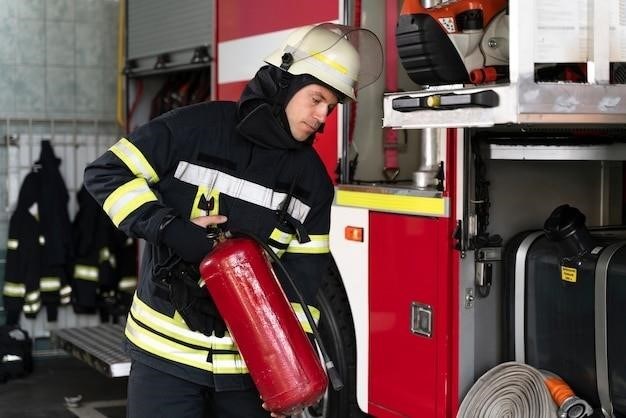NFPA 25 Fire Pump Testing⁚ A Comprehensive Guide
This comprehensive guide provides an in-depth overview of NFPA 25, a critical standard governing the inspection, testing, and maintenance of water-based fire protection systems. From weekly inspections to annual flow tests, we delve into the essential components of fire pump testing, outlining the requirements and procedures to ensure proper operation in emergency situations. This guide also covers documentation and reporting, providing resources for further exploration of NFPA 25 and fire pump testing.
Introduction
NFPA 25, Standard for the Inspection, Testing, and Maintenance of Water-Based Fire Protection Systems, is a crucial document that outlines the essential procedures for ensuring the reliability and functionality of fire pumps. These pumps play a vital role in delivering water to sprinkler systems, standpipes, and other fire suppression equipment, providing a critical line of defense in the event of a fire. Fire pumps must be regularly inspected, tested, and maintained to ensure they are ready to operate effectively when needed.
NFPA 25 provides a comprehensive framework for maintaining fire pump systems, covering various aspects, including⁚
- Weekly inspections to identify potential issues and ensure proper operation.
- Monthly no-flow (churn) tests to verify the pump’s ability to operate without delivering water.
- Annual flow tests to assess the pump’s performance under actual flow conditions.
By following the guidelines set forth in NFPA 25, building owners, facility managers, and fire protection professionals can ensure that fire pumps are properly maintained and ready to deliver their vital function in protecting lives and property.
Importance of NFPA 25
NFPA 25 holds paramount importance in the realm of fire safety, serving as the cornerstone for maintaining the integrity and reliability of water-based fire protection systems. Its rigorous standards ensure the proper functioning of fire pumps, a crucial element in safeguarding lives and property. NFPA 25 mandates comprehensive inspection, testing, and maintenance procedures, encompassing weekly, monthly, and annual evaluations. These procedures are designed to identify potential issues early on, preventing failures during emergencies.
The importance of NFPA 25 is underscored by its impact on⁚
- Public Safety⁚ NFPA 25 helps protect lives by ensuring fire pumps operate effectively during emergencies, providing a vital water supply for fire suppression systems.
- Property Protection⁚ Adhering to NFPA 25 standards helps minimize fire damage and financial losses by ensuring the reliability of fire suppression systems.
- Compliance and Liability⁚ NFPA 25 compliance is often mandated by building codes and insurance companies, helping to protect building owners and managers from legal liabilities.
In essence, NFPA 25 serves as a vital safeguard for the well-being of individuals and the security of assets, making it an indispensable tool in achieving comprehensive fire safety.
Key Components of NFPA 25 Fire Pump Testing
NFPA 25 fire pump testing encompasses a comprehensive set of procedures designed to ensure the consistent reliability of fire pumps. These procedures are categorized into different frequencies, each serving a specific purpose in maintaining the system’s overall integrity.
The core components of NFPA 25 fire pump testing include⁚
- Weekly Inspections⁚ These routine checks involve visually examining the pump and its associated components, including valves, gauges, fuel and oil levels, electrical systems, ventilation, and heating. This helps identify any immediate issues and prevent them from escalating.
- Monthly No-Flow (Churn) Tests⁚ This test involves running the pump without water flow for a specified duration. It verifies the pump’s ability to start automatically, checks its operation, and ensures proper lubrication.
- Annual Flow Tests⁚ These are the most comprehensive tests, involving simulating actual fire scenarios. The pump is run at various flow rates and pressures to assess its performance, verify its ability to meet the required flow demands, and ensure proper operation of all components.
By diligently executing these components, organizations can ensure their fire pumps are in optimal working order, ready to combat any fire emergency effectively;
Weekly Inspections
Weekly inspections are the cornerstone of NFPA 25 fire pump testing, serving as a crucial first line of defense in ensuring the system’s readiness for a fire emergency. These inspections are designed to be a quick and efficient way to identify any potential issues before they escalate into major problems. The frequency of these checks ensures that any potential problems are addressed promptly, reducing the risk of system failure during a critical event.
A typical weekly inspection checklist includes⁚
- Visual Inspection of Components⁚ This involves examining the pump itself, its associated valves, gauges, fuel and oil levels (for diesel pumps), electrical systems, ventilation, and heating systems. Any signs of wear, damage, or leakage should be noted and addressed promptly.
- Confirmation of Pump Operation⁚ The inspection should include a confirmation of the pump’s ability to start automatically. This is a critical step in ensuring that the pump will respond as expected in an emergency situation.
While these inspections may seem straightforward, they are essential for maintaining the fire pump system’s integrity and ensuring its reliable operation when needed.
Monthly No-Flow (Churn) Tests
Monthly no-flow tests, often referred to as “churn” tests, are an essential part of NFPA 25 fire pump testing, designed to ensure that the pump’s internal components are properly lubricated and functioning correctly. These tests involve running the pump without any water flow, simulating the initial stages of a fire emergency. This allows for the pump’s internal components to be exercised and lubricated, preventing premature wear and tear, and ensuring the pump’s readiness for a full flow test.
During a churn test, the fire pump is run for a specified duration, typically 10 minutes for electric pumps and 30 minutes for diesel pumps. While the pump is running, a qualified technician should be present to monitor the pump’s operation and ensure that all components are functioning as expected. They should also check the pump’s pressure gauge and sensor accuracy, and any unusual noises or vibrations should be noted and investigated.
Churn tests are a critical component of preventative maintenance, ensuring that the fire pump remains in top condition and ready to deliver its vital water supply when needed.
Annual Flow Tests
Annual flow tests are the most comprehensive and critical component of NFPA 25 fire pump testing. These tests simulate a real fire scenario, ensuring the pump can deliver the necessary water pressure and volume to extinguish a fire. The test involves running the pump at various flow rates, typically at 100% and 150% of its rated capacity, while measuring the pressure and flow output.
During the flow test, a qualified technician will monitor the pump’s performance, ensuring it meets the specifications outlined in the pump’s nameplate data. Any deviation from these specifications could indicate a problem with the pump’s performance and should be investigated and addressed promptly. The test results are then documented and recorded, providing a historical record of the pump’s performance and identifying any potential issues that may require attention.
Annual flow tests are a crucial aspect of fire pump maintenance, ensuring that the pump is capable of delivering its vital water supply in the event of a fire. They are a critical component of maintaining a safe and reliable fire protection system.

NFPA 25 Requirements for Fire Pump Testing
NFPA 25 outlines a comprehensive set of requirements for fire pump testing, encompassing various aspects of the fire pump system. These requirements ensure that the fire pump, its associated electrical system, and controller operate reliably and meet the demands of a fire emergency. The standard addresses critical elements such as pump system requirements, including the pump itself, its associated piping, and valves, as well as the electrical system, covering the motor, wiring, and controls.
NFPA 25 also specifies requirements for the fire pump controller, which is responsible for initiating and controlling the pump’s operation. These requirements encompass the controller’s ability to start and stop the pump automatically, monitor the pump’s performance, and provide an alarm in case of malfunction. By adhering to these requirements, building owners can ensure that their fire pump systems are properly tested and maintained, providing a critical line of defense in the event of a fire.

Pump System Requirements
NFPA 25 sets forth stringent requirements for the pump system itself, ensuring its proper operation and reliability. These requirements address various aspects of the system, including the pump, its associated piping, and valves. For instance, the pump’s performance must be evaluated against its nameplate data, ensuring it can deliver the required flow and pressure during a fire. This involves testing the pump’s performance at different flow rates and pressures, verifying its ability to meet the demands of the fire protection system.
Additionally, NFPA 25 mandates that the pump’s couplings be aligned properly, preventing excessive wear and tear on the pump shaft. The piping system must be inspected for leaks, corrosion, and obstructions, ensuring free flow of water to the fire protection system. Valves within the system, such as check valves and gate valves, must be tested for proper operation, ensuring they can control the flow of water as intended.
Electrical System Requirements
NFPA 25 places significant emphasis on the electrical system powering the fire pump, recognizing its crucial role in ensuring the pump’s functionality during an emergency. The standard mandates that the electrical system be inspected and tested regularly to verify its integrity and reliability. This includes checking the voltage and amperage readings, ensuring they fall within acceptable ranges. Additionally, the electrical system’s components, such as switches, circuit breakers, and wiring, must be inspected for damage or deterioration, ensuring they are in proper working condition.
NFPA 25 also emphasizes the importance of qualified personnel for electrical work. The replacement of components within the electrical system, including the fire pump controller and drivers, should be performed by factory-authorized representatives or qualified individuals approved by the authority having jurisdiction. This ensures that the work is completed to the highest standards, maintaining the integrity and safety of the electrical system.
Controller Requirements
The fire pump controller is a vital component that orchestrates the pump’s operation, ensuring its timely and efficient response in a fire emergency. NFPA 25 sets forth specific requirements for the inspection, testing, and maintenance of fire pump controllers, emphasizing their critical role in fire safety. These requirements aim to ensure that the controller is in proper working order and can reliably activate the pump when needed.
NFPA 25 mandates that the controller be factory calibrated and adjusted to a specific tolerance, typically within 3 percent. This ensures that the controller functions accurately and responds appropriately to the demands of the fire pump system. The voltage reading of the controller is also subject to strict scrutiny, requiring it to be within 5 percent of the rated voltage. This ensures that the controller receives adequate power and can operate effectively.
Regular inspection and maintenance of the fire pump controller are essential to ensure its continued reliability. The controller’s components, including wiring, connections, and electrical components, should be examined for any signs of damage, deterioration, or corrosion. This proactive approach helps prevent potential failures and ensures that the controller remains capable of fulfilling its critical role in fire safety.
Fire Pump Testing Procedures
NFPA 25 outlines a comprehensive set of procedures for testing fire pumps, ensuring their functionality and readiness in emergency situations. These procedures encompass a variety of tests designed to evaluate different aspects of the pump’s performance, including its ability to start automatically, maintain proper pressure, and deliver the required flow rate.
One crucial procedure is the automatic starting test, which simulates a fire scenario by reducing the water pressure at the control switch, triggering the pump’s automatic activation. This test verifies the pump’s ability to respond promptly and reliably to a fire event, ensuring that water is available when needed.
Another essential test involves checking the accuracy of pressure gauges and sensors. These instruments provide vital information about the pump’s operation and ensure that the system is operating within safe and effective parameters. The test involves comparing the gauge readings to known values, verifying their accuracy and ensuring that the system’s pressure monitoring functions correctly.
Finally, the pump coupling alignment check ensures that the pump’s shaft is properly aligned with the driver, preventing excessive wear and tear and ensuring smooth operation. This test involves visually inspecting the alignment and making adjustments if necessary, ensuring that the pump operates efficiently and effectively.
Automatic Starting Test
The automatic starting test is a critical component of NFPA 25 fire pump testing, simulating a fire scenario to assess the pump’s ability to respond promptly and reliably to an emergency. This test involves triggering the pump’s automatic activation by reducing the water pressure at the control switch, mimicking the conditions that would occur during a fire.
During the test, the pump should start within a predetermined time frame, typically specified by the manufacturer or local regulations. The test evaluates the pump’s response time, ensuring that it can deliver water to the fire suppression system quickly and effectively.
The automatic starting test also verifies the functionality of the pump’s control system, ensuring that it can properly detect a pressure drop and initiate the pump’s activation. This test is essential for ensuring that the fire pump can reliably deliver water to the fire suppression system when needed, safeguarding lives and property in the event of a fire.
Pressure Gauge and Sensor Accuracy Check
Accurate pressure readings are essential for ensuring the proper operation of fire pumps and the entire fire suppression system. NFPA 25 mandates regular checks of pressure gauges and sensors to guarantee their accuracy and reliability. These checks are crucial for detecting any discrepancies that could compromise the system’s performance.
Pressure gauges and sensors measure the pressure within the fire pump system, providing vital information for monitoring system performance and identifying potential issues. During the accuracy check, readings from the gauges and sensors are compared to known reference points or calibrated instruments. Any discrepancies beyond the acceptable tolerance levels require immediate attention, potentially involving gauge calibration or sensor replacement.
Regular pressure gauge and sensor accuracy checks play a vital role in maintaining the integrity of the fire suppression system. By ensuring accurate pressure readings, these checks contribute to the overall reliability and effectiveness of the system, safeguarding lives and property from fire hazards.



